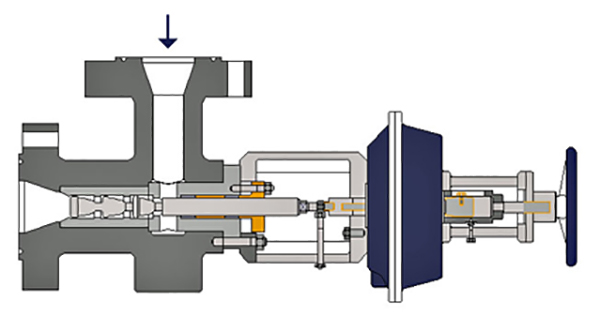Hydrocracking Valve

In the hydrocracking process, gas, oil or residue feed is cracked in the presence of a catalyst and hydrogen which is added under high temperature and elevated pressure (between 100bar and 180bar), and converted by cracking and hydrogenation in a series of reactors.
The resulting effluent and unconverted oil (UCO) is then routed to the Hot High Pressure Separator – HHPS. Hydrogen-rich gases are flashed off overhead and sent to the Cold High Pressure Separator CHPS for additional separation.
The remaining effluent from both the HHPS and CHPS are then sent to a fractionator. The fractionator removes butane and lighter gases overhead; naphtha, jet fuel and diesel as liquid side streams and the unconverted oil at the bottom.
A number of critical control valves are required:
HHPS letdown control valve to fractionator
CHPS letdown control valve to fractionator
Sour water letdown drum control valve
Hydrogen to flare control valve
HHPS or CHPS letdown to fractionator
The effluent exiting the HHPS is then depressurised through a multi-stage control valve. The pressure must be let down from approximately 180bar to 2bar. Additionally flashing can be expected.
The outward opening SchuF Multistage Control Valve (Model 74TS) that can be equiped with up to six pressure reducing discs is ideal for this high pressure service. The flow-to-open design reduces flashing in the valve and eliminates plugging by catalyst fines.
Multi-stage Pressure Let Down Control Valve, Fig.:©SchuF
The depressurised and converted hydrocarbon fractions can now be safely further processed in the fractionator.
Sour Water Letdown
An additional output of of the CHPS is sour water, which is sent to the sour water flash drum to remove residual hydrogen sulphide and ammonia. In this instance the pressure must be reduced from approximately 100bar to atmosphere, flashing occurs and the entrained catalysts and H2S and NH3 can cause severe erosion. Vibration can also be a concern.
The SchuF Model 74BS X-Flash is ideally suited to this application, by virtue of its outward opening disc design, allowing flashing to take place outside the valve. Errosion is minimised, and plugging does not arise.
This single-stage letdown valve is also ideal for services with vibration. The rugged strong construction, and in particular the one-piece stem and disc ensure long valve life.
Letdown to Flare
A part of the hydrogen-rich gases exiting the HHPS are recycled to the start of the processor to the CHPS. However, cases can arise when hydrogen is not required by the CHPS or cannot be recycled. In these cases the valuable hydrogen must be vented to flare.
The ideal valve for this service should exhibit exact control, class VI shut-off (hydrogen is a valuable commodity) and good noise attenuation. This is achieved in a special SchuF control valve with a “Cage Release” trim. The valve has a multi-hole cage disc design. The holes are placed according to the flow characteristics and noise attenuation required. In particular, Class VI leakage rate (API 598) is achieved.
SchuF Control Valve Design
In severe service applications such as Hydrocracking SchuF often proposes valves that have a flow-to-open design (rather than the more common flow-to-close).
In a flow-to-open design the valve disc opens outwards from the valve seat. This reduces plugging that may occur due to catalyst fines.
For cleaner fluids, or in case of customer preference we can also supply flow-to-close versions (the advantage here being the use of smaller actuators).
High Pressure Booster Pump Recirculation
Another application is for high-pressure booster pump recirculation control, sometimes also referred to as a booster Automatic Recirculation Valve. During start-up these pumps may not run dry, so that these valves allow the pump to run a “closed loop”. Therefore, the valve will have to dissipate the complete pressure built up by the booster pump. Once start-up is completed the valve is closed. Tight shutoff is required in this case.
SchuF has delivered the valves to some of the the most severe hydrocracker processes as well as HHPS services in coal liquefaction and hydrotreating.
Our valves have been in trouble-free use for several years.